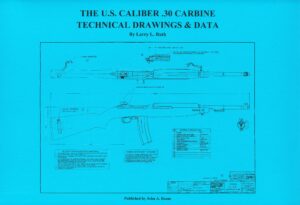Jim Dickson
Contributing Editor
The U.S. Caliber .30 Carbine Technical Drawings and Data
By Larry L. Ruth
Published by
John A. Baum
5678 State Rt. 45
Lisbon Ohio 44432
182 pages, 12” X 18”, $95 which includes U.S. Postage and Insurance
This epic compilation of the Rock Island Arsenal drawings for making the M1 carbine was a monumental task.
Author Larry Ruth had the material which he had gotten from Rock Island Arsenal but as anyone who has worked with old Army prints knows the photos and drawings are not of the best quality appearance to begin with and the dirt and folds and tears over time make them look worse. It took John Baum three months of intense hard work to enhance the photos and clean up the original drawings as well as putting everything in a proper format. The clarity and quality is now better than when they were first printed in WW2.
(Ruth has authored several books on the M1 Carbine. See related story, Oct. 5, 2020.—Editor)
Prints are assembled on a plastic spiral binder so that they will open and lay flat for a machinist to work from them easily. They are printed on 28-pound paper which is 40% heavier than standard typewriter paper so the big 12” X 18” pages (a necessity to keep everything at a proper, easily readable size) will hold up in use.
The book begins with the various Army color training posters and some WW2 Winchester ads touting the carbine. Then we come to the meat of the matter, the M1 carbine production data. Everything the manufacturers had to work with when they produced the M1 carbine in WW2. It also includes the production data on the magazines and ammunition. All the special tools, test, and support equipment are covered as well.
This material is vital for every M1 carbine owner. The WW2 surplus spare parts are almost completely gone now and the commercial copies often do not meet the Mil-Specs. In addition, a lot of the M1 carbine parts that the government rejected have shown up on the market. The worst offender was a lot of chrome lined barrels made about 1972 that the Army refused. The chrome lining was improperly done so that many would not chamber a cartridge. The heat treatment was done wrong resulting in a number of these barrels bursting when put on civilian’s guns.
Many of the civilian copies of the M1 carbine also fail to meet Mil-Specs resulting in guns that are unreliable and cannot be fixed. This is why I can only recommend original army surplus M1 carbines. I recently had a new commercial M1 carbine that would not feed and was actually unsafe to fire. The M1 carbine is totally unforgiving of any deviation in the Mil-Specs. Tolerances are tight, often .005-inch, and changes to make the parts easier to make on modern machinery seem to invariably compromise reliability.
With this production drawing package you can check to see if your parts are correct are not. If your gun doesn’t work reliably you can see why and know what needs doing to fix it. A good machinist can make individual parts or even the entire gun from these drawings. With the intense push to ban guns it is important to make production drawings available. Any company wanting to make the M1 carbine right can get a copy of these drawings and be sure that their guns will work if they conform exactly to them just as the WW2 guns were required to do.
These original drawings are the result of the concentrated effort of Army Ordnance and the companies making the gun combined with the input of the combat experience of the troops using them. It would be impossible to duplicate this today. That’s why it is so important that they be preserved and distributed as widely as possible.




